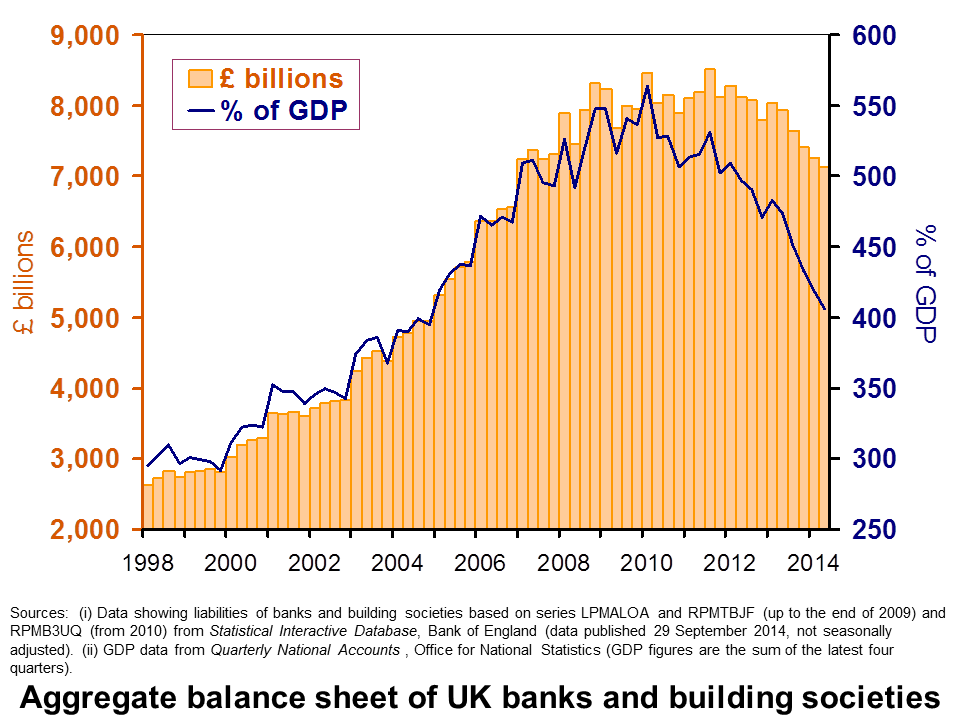Does a shrinking banking sector balance sheet signal the end for credit cycles?
 Following the financial crisis, all sectors of the economy continue to repair their balance sheets. As well as households, non-financial corporations and government, this is true of the banking sector. In part, the repairing and rebalancing of their balance sheets is being brought about by regulatory pressures. The objective is to make banks more resilient to shocks and less susceptible to financial distress.
Following the financial crisis, all sectors of the economy continue to repair their balance sheets. As well as households, non-financial corporations and government, this is true of the banking sector. In part, the repairing and rebalancing of their balance sheets is being brought about by regulatory pressures. The objective is to make banks more resilient to shocks and less susceptible to financial distress.
The need for banks to repair and rebalance their balance sheets is significant because of their systemic importance to the modern-day economy. Financial institutions that are systemically important to national economies are know as SIFIs (systemically important financial institutions) while those of systemic importance to the global economy are know as G-SIFIs or G-SIBs (global systemically important banks). The increasing importance of financial institutions to economic activity is known as financialisation.
 One way of measuring the degree of financialisation here in the UK is to consider the aggregate size of the balance sheet of resident UK banks and building societies (including foreign subsidiaries operating here). The chart shows that the balance sheet grew from £2.6 trillion in 1998 Q1 to £8.5 trillion in 2010 Q1. Another way of looking at this is to consider this growth relative to GDP. This reveals that the aggregate balance sheet of banks and building societies grew over this period from 3 times annual GDP to a staggering 5.6 times GDP. (Click here for a PowerPoint of the chart.)
One way of measuring the degree of financialisation here in the UK is to consider the aggregate size of the balance sheet of resident UK banks and building societies (including foreign subsidiaries operating here). The chart shows that the balance sheet grew from £2.6 trillion in 1998 Q1 to £8.5 trillion in 2010 Q1. Another way of looking at this is to consider this growth relative to GDP. This reveals that the aggregate balance sheet of banks and building societies grew over this period from 3 times annual GDP to a staggering 5.6 times GDP. (Click here for a PowerPoint of the chart.)
But, now consider the aggregate banking balance sheet in the 2010s. This reveals a shrinking balance sheet. At the end of the second quarter of this year (2014 Q2) it had fallen back to £7.1 trillion or 4 times GDP. As a share of GDP, this was the smallest the aggregate balance sheet had been since 2005 Q1.
Does a shrinking balance sheet matter? This is where the analysis becomes tricky and open to debate. If the smaller size is consistent with a more stable financial system then undoubtedly that is a good thing. But, size is not that all matters. The composition of the balance sheet matters too. This requires an analysis of, among other things, the liquidity of assets (i.e. assets that can be readily turned in a given amount of cash), the reliability of the income flow from assets and the resources available to withstand periods of slow economic growth, including recessions, or periods of financial difficulty.
As we have identified before (see Financialisation: Banks and the economy after the crisis), the financial crisis could herald new norms for the banking system with important implications for the economy. If so, we may need to become accustomed to consistently lower flows of credit and not to the levels that we saw prior to the financial crisis of the late 2000s. However, an alternative view is that we are merely experiencing a pause before the next expansionary phase of the credit cycle. This is consistent with the financial instability hypothesis (see Keeping a Minsky-eye on credit) which argues that credit cycles are an integral part of modern financialised economies. Only time will tell which view will turn out to be right.
Articles
‘Cleaning up bank balance sheets is key’ Irish Examiner, John Walsh (10/10/14)
More action needed at European banks: Fitch Courier Mail, (17/10/14)
Bank lending to small businesses falls by £400m The Telegraph, Rebecca Burn-Callander (20/10/14)
Bank lending to SMEs falls by £400m SME insider, Lindsey Kennedy (21/10/14)
Record world debt could trigger new financial crisis, Geneva report warns The Guardian, Phillip Inman (29/10/14)
RBS shares jump as bank’s bad debts improve The Guardian, Jill Treanor (30/10/14)
Data
Statistical Interactive Database Bank of England
Questions
- Using examples, demonstrate your understanding of financialisation.
- Draw up a list of the alternative ways in which we might measure financialisation.
- What factors are likely to explain the recent reduction in the aggregate balance sheet of resident banks and building societies in the UK?
- How might we go about assessing whether the aggregate level of lending by financial institutions is sustainable?
- How might we go about assessing whether the level of lending by individual financial institutions is sustainable?
- How would reduced flows of credit be expected to impact on the economy both in the short term and in the longer term?
- Are credit cycles inevitable?
- Of what significance are credit cycles in explaining the business cycle?